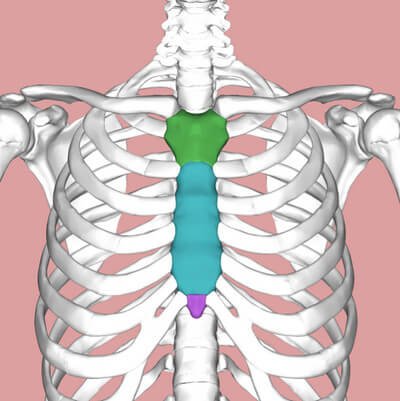Xiphoid Process and Pain Definition
Other names for the xiphoid process are processus xiphoideus, ensiform or xiphoid appendix. It rests at the 10th thoracic vertebra.
It is the tiniest and lowest part of the sternum. Unlike the other two parts of the sternum namely manubrium and body, there are costal cartilages and ribs that are attached to the xiphoid process.
- Attached to the anterior surface of the xiphoid process are the anterior costoxiphoid ligament and a section of the rectus abdominis muscle.
- The posterior surface serves as an attachment to the posterior costoxiphoid ligament, transversus thoracis muscle, and diaphragm.
- Xiphisternal joint connects the sternal body to the xiphoid process’ superior border.
- There are articular facets on both sides of the superior border where the 7th ribs attach.
- Abdominal aponeuroses are attached to the lateral borders of the xiphoid process.
The xiphoid process is made up of cartilage until the person reaches the age of 40 wherein it ossifies. In some cases, the xiphoid process fuses with the sternal body when the person reaches the old age. The ossification of the xiphoid process presents itself as a lump that is commonly thought by patients as a tumor that may cause cancer. They have to be reassured that it is a normal development of the xiphoid process [1, 2, 3].
Photos of Anatomy: Where is the Xiphoid Process Located?

Picture 1: Sternum lies on the anterior midline aspect of the thoracic wall. There are three parts: manubrium (green), body (blue), and xiphoid process (violet).
Image Source: wikipedia.org

Picture 2: The xiphoid process is colored red.
Image Source: wikipedia.org
Clinical Significance: What is the Function of Xiphoid Process?
The xiphoid process is very small anatomical structure. Despite of its size, it is very important because it serves as a landmark for:
- Subcostal or infrasternal angle that is formed by the right and left subcostal margins and the xiphoid process
- Lower margin of the heart
- Superior end of the liver
- Inferior limit of the anterior thoracic cage
- Central tendon of the diaphragm [3]
Xiphoid Process Pain
Causes of Xiphoid Process Pain
Xiphoidalgia
Also known as xiphoidynia or hypersensitive xiphoid syndrome, xiphoidalgia presents as a deep sharp pain that is felt on the xiphoid process that worsens when pressed. Overeating and movement that involves the use of xiphoid process, such as bending, stooping, and twisting, aggravates the pain.
It resembles the chest pain in heart attack. The xiphisternal joint may appear swollen and feel sore. The pain may radiate to the back of the sternum, precordium, epigastrium, shoulders, and back. The patient suffers the pain for minutes to hours and may persist in weeks or months.
Patients with enlarged xiphoid process with xiphisternal angle of less than 160 degrees are more likely to develop xiphoidalgia. Though the pain may be too much, xiphoidalgia is self-limiting, meaning it goes away on its owneven without treatment [4, 5, 6].
CPR and Sternum Pain
The thoracic cage is designed to protect all of the surrounding structures from trauma or injury. But like anything else, it has a breaking point. If the sternum cannot handle any more pressure that comes to it, fracture and dislocation becomes the problem.
A common mistake in the performance of cardiopulmonary resuscitation (CPR) is the wrong placement of the rescuer’s hand on the patient’s chest. When it is too low, xiphoid process may be fractured and protrude on the underlying organs. A sign when it becomes broken is when you sense a “pop” [7, 8].
Also see : Pain under right rib cage
Gastroesophageal Reflux Disease (GERD)
GERD refers to the regurgitation of gastric acid from the stomach to the esophagus.
The esophagus is an alkaline environment, which is the total opposite of the acidic environment of the stomach. It is located behind the sternum. The esophagus runs from the throat down to the stomach. Anatomically speaking, the proximity of the esophagus and xiphoid process, explains why you feel sternum pain in GERD.
Moreover, the trigger points for somatovisceral symptoms such as heartburn lies surrounding the xiphoid process that is why you feel xiphoid process pain in GERD [9].
Treatment for Xiphoid Process Pain
- Analgesics and nonsteroidal anti-inflammatory drugs (NSAIDs) are the first line of painkillers that may be given to patients with xiphoid process pain.
- If it cannot be handled by the first line agents, opioid analgesics may be necessary to decrease the pain.
- Injection of lidocaine or corticosteroids into the xiphisternal joint is eventually administered if none of the above works.
- Heat application over the xiphoid process provides relief.
- Gentle exercise of chest wall muscles gives you a better chance of mobility in the long run.
- Elastic rib belt provides pressure to the sternal area thereby diminishing the pain [5, 6].
References:
- Gray H, Anatomy of the Human Body, Bartleby Bookstore
- Moore KL et al, Clinically Oriented Anatomy 6th edition, Lippincott Williams & Wilkins 2010, pp 76-78
- Snell RS, Clinical Anatomy by Regions 9th edition, Lippincott Williams & Wilkins 2012, p 35
- Fishman SM, Bonica’s Management of Pain, Lippincott Williams & Wilkins 2012, p 1063
- Klippel JH et al, Primer on the Rheumatic Diseases, Springer Science and Business Media 2008, p 84
- Waldman SD, Atlas of Uncommon Pain Syndromes, Elsevier Health Sciences 2013, p 193-194
- Tortora GJ & Derrickson B, Principles of Anatomy & Physiology 13th edition, Biological Science Textbooks Inc. 2012, p 245
- Ellis H, Clinical Anatomy 11th edition, Blackwell Publishing 2006, p 11
- Ferguson LW & Gerwin R, Clinical Mastery in the Treatment of Myofascial Pain, Lippincott Williams & Wilkins 2005, p 316
